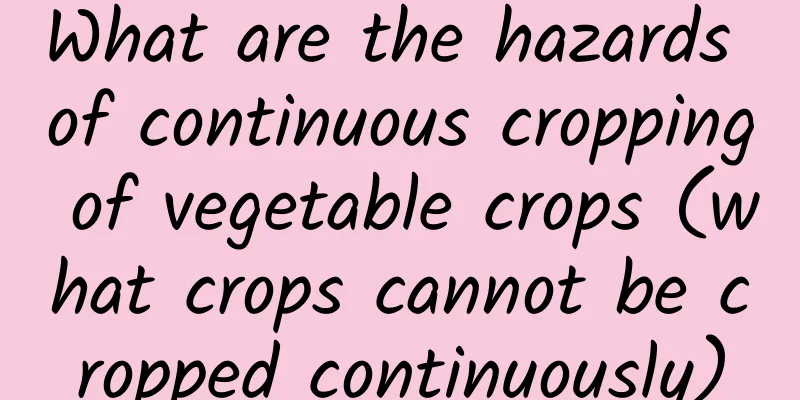What are the hazards of continuous cropping of vegetable crops (what crops cannot be cropped continuously)

The harm of continuous croppingContinuous cropping of crops and vegetables refers to planting the same type of crops in the same plot of land within one year or in successive years. The direct harm caused by continuous cropping is what we often call the phenomenon of repeated cropping. The specific causes and phenomena are as follows: 1. Common diseases of this crop, especially soil-borne diseases, are gradually getting worse. Due to continuous cropping, the pathogens produced by the previous crops remain in the soil and gradually accumulate, resulting in increasingly serious diseases when the crops are planted again. In particular, the occurrence of soil-borne diseases such as wilt, damping-off, damping-off, root rot, bacterial wilt, and vine blight is becoming more and more serious. 2. The nutrient content in the soil decreases and the soil quality declines. During continuous cropping, the same type of crops have the same demand for nutrients, and the consumption over the years is constant. Although farmers will provide targeted fertilizer supplements, the supplementary fertilizers are mostly nitrogen, phosphorus and potassium nutrients, and organic matter and trace elements are often insufficient. When the crop's preferred nutrients are over-consumed, its growth and yield will decline when it is planted again. At the same time, organic matter and beneficial microorganisms will also decrease, leading to the destruction of soil aggregate structure and reduced permeability, which is not conducive to root survival. This will also cause the effect of fertilizer use to become increasingly poor. 3. The self-poisoning phenomenon of plants worsens. Competition is everywhere in nature, and there are competitors in the same crop. In order to grow well, the roots of crops will secrete some substances that are toxic to the same crops to inhibit the growth of competitors. This situation is not obvious at the beginning, but it will become more and more obvious as the years go by. The crops in the field grow in different heights and strengths. Which crops cannot be planted continuously?1. Leguminous crops Leguminous crops are most afraid of repeated cropping. If they are planted continuously, the seedlings will be attacked by viruses. In rural areas, it is called fire dragon disease. After the seedlings emerge, the branches and leaves do not grow, and gradually shrink, and finally dry up and die. Such crops include: soybeans, beans, cowpeas, peas, etc. 2. Melon crops Like bean vegetables, melon vegetables are most afraid of repeated cropping. Once repeated cropping occurs, the leaves will turn yellow, wither and curl, and the flowers will fall off. Moreover, the melon vines may become stunted, stop growing, turn yellow, and age prematurely. In serious cases, the seedlings dry up and die before they even bloom, such as cucumbers, watermelons, pumpkins, loofahs, winter melons, etc. 3. Eggplant and pepper should not be planted repeatedly. After eggplant and pepper are planted again, the plants will suffer from serious diseases and abnormal growth. Common symptoms include root diseases, leaf withering, root rot, and plant death. Because these diseases are caused by continuous cropping and are not ordinary diseases, they are difficult to prevent and control with drugs. Therefore, when planting eggplant or pepper plants, be sure not to plant them continuously in one place. Rotate them with other vegetables to reduce the occurrence of diseases and obtain high yields. 4. Garlic and onion cannot be planted repeatedly Garlic and onions should not be planted in the same field in succession. If garlic or onions are planted continuously in the same field, a toxin will form in the soil. It will cause the leaves to turn yellow, the plants to become weak and grow poorly. More seriously, it will directly lead to root rot, seriously affecting yield and quality. Therefore, garlic and garlic, onions and onions, or garlic and onions cannot be planted continuously. They need to be rotated with other crops. The most direct and effective way to solve the problem of continuous cropping is to rotate crops appropriately, and crops of the same type or family should not be planted continuously. In terms of vegetable cultivation, if Cucurbitaceae vegetables, Solanaceae vegetables, Cruciferous vegetables, ginger and other crops are planted continuously, the harm will be more obvious. Especially for ginger planting, I heard that after one or two years of planting, you can no longer plant ginger on that land, otherwise ginger blight, wilt and other diseases will become very serious. Continuous cropping is not absolutely impossible. By taking appropriate measures, such as increasing the application of organic fertilizers, microbial fertilizers, timely cleaning of gardens and other means to improve the soil, the harm can be reduced or mitigated. |
>>: What is the appropriate spacing and depth for garlic planting?
Recommend
How to solve the problem of Schefflera falling leaves
1. Inappropriate light exposure Reason: Inadequat...
How to keep seeds of Solanum nigrum and how to collect seeds
How to keep seeds of Solanum nigrum Solanum nigru...
How to water bamboo orchid
1. Watering principles Water when it is dry, stop...
How to prune willow-leaf peach
When to prune willow-leaf peach Generally, there ...
How to grow Anthurium to make it bloom?
Anthurium is also known as Spathiphyllum and Smoo...
When is the best time to prune the iron tree?
Pruning time for iron trees Pruning of cycads is ...
The breeding methods and precautions of Chinese giant thorn
1. Soil It is best to use well-drained, fertile a...
Advantages and Disadvantages of Western Earth Roses
The Western Earth Rose is a variety of climbing r...
What are the cultivation methods and precautions for osmanthus trees?
Osmanthus tree cultivation method Osmanthus adapt...
The fastest way to root Chinese toon cuttings
Toona sinensis cutting time Toona sinensis cuttin...
Where do cabbage seeds come from?
How to get cabbage seeds Cabbage seeds grow insid...
Causes and treatments of yellow cucumber leaves
1. Too much watering 1. Reason: Cucumber is a wat...
Goose breeding technology and management
Goose is a kind of poultry that mainly feeds on g...
How to grow Kalanchoe
1. Breeding methods 1. Sunlight: Kalanchoe needs ...
Want to fatten up your succulents? I starved it for a few meals and it actually grew fat!
Why can Rourou grow into a fat boy by skipping a ...









